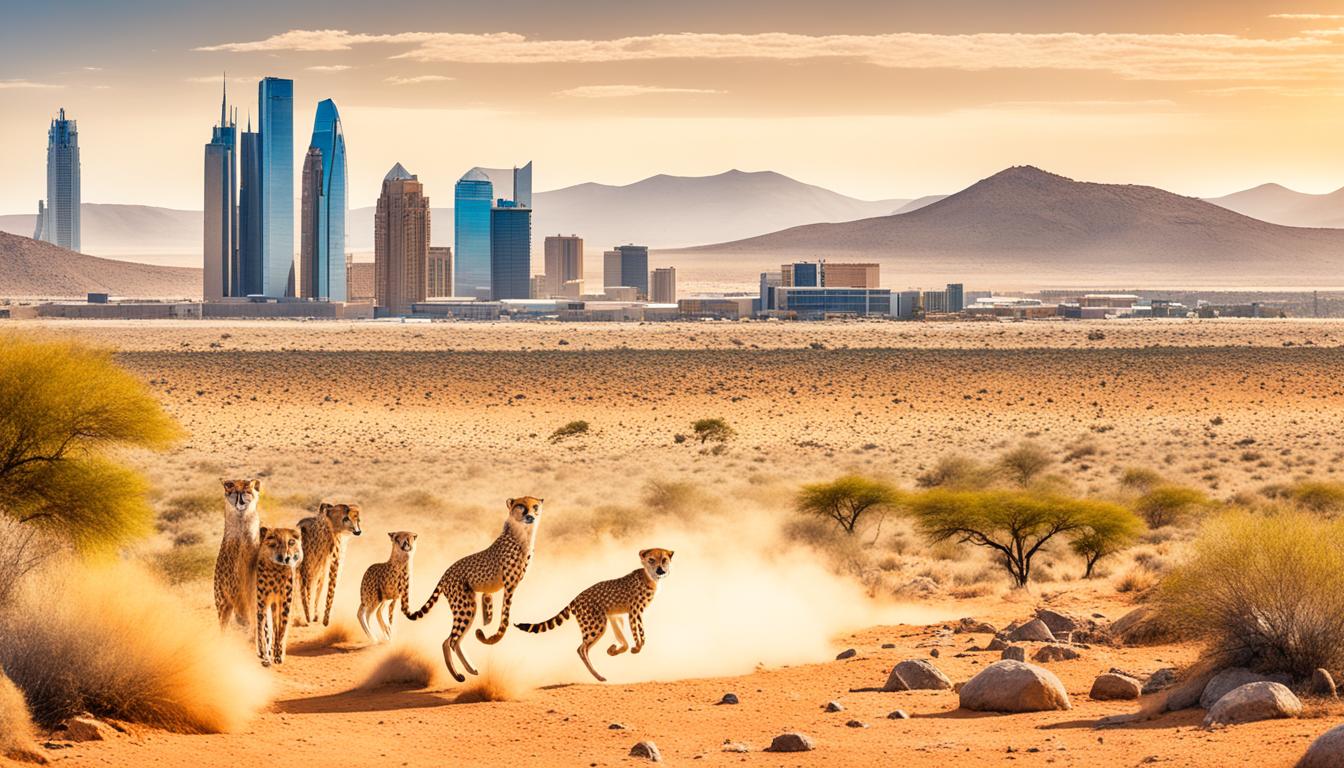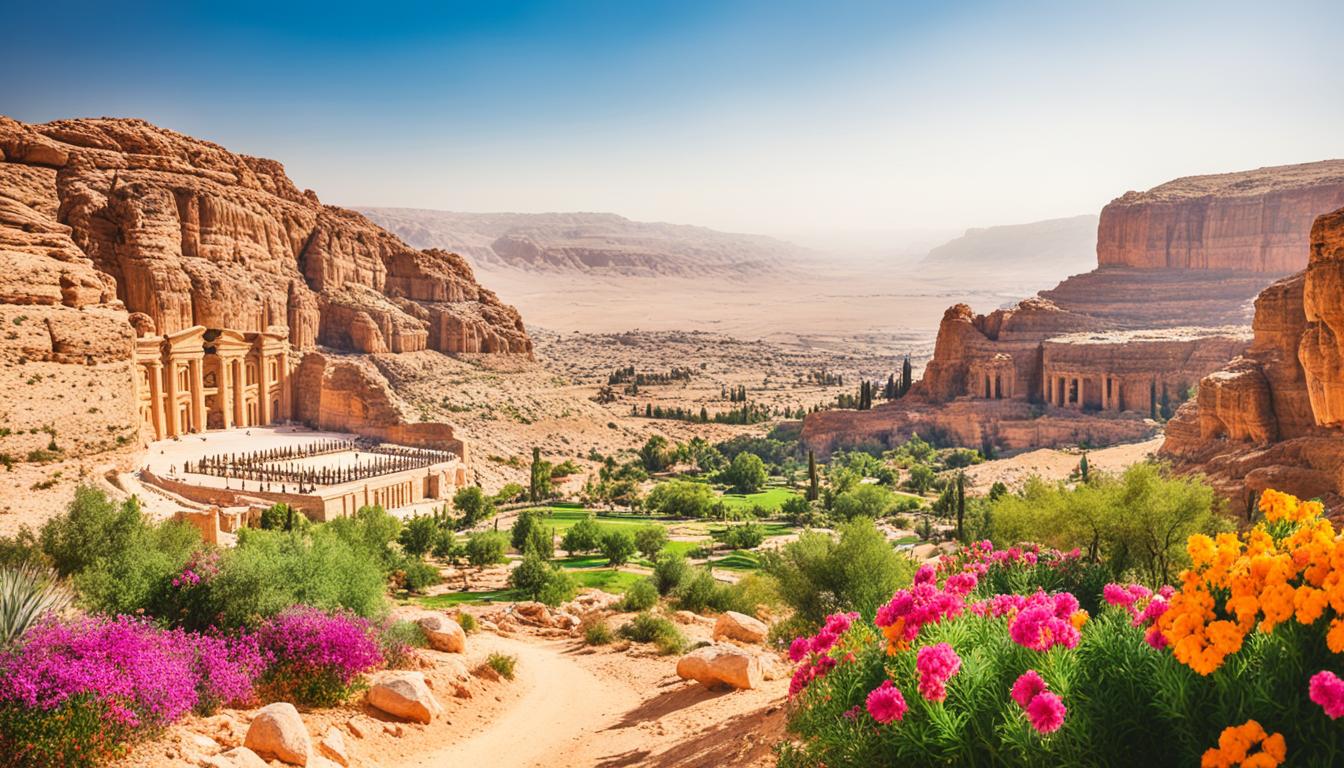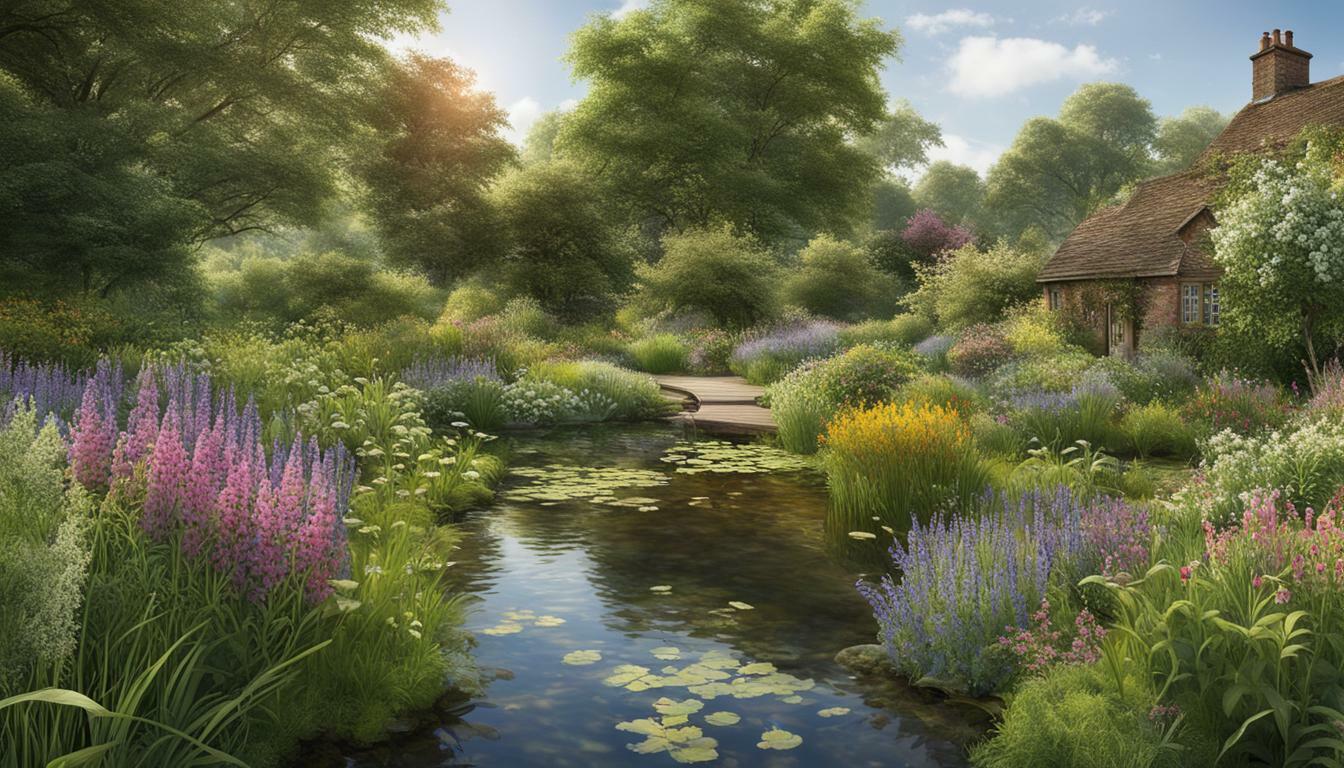Nauru Biodiversity and the Built Environment
Did you know that Nauru, a small island nation in the South Pacific Ocean, is home to a unique and fragile biodiversity? With only 56 native species and 125 naturalized species, Nauru’s biodiversity may seem limited, but its impact is significant. The conservation of Nauru’s environmental treasure is crucial for sustainable development and the preservation of this delicate ecosystem.
Key Takeaways:
- Nauru’s biodiversity is characterized by a small number of native and naturalized species.
- Conservation efforts are essential to protect Nauru’s fragile ecosystem.
- Sustainable development and the built environment play a crucial role in preserving biodiversity.
- Effective measures such as habitat preservation and green infrastructure integration are being implemented in Nauru.
- Collaborative efforts are needed to address the challenges facing Nauru’s biodiversity.
Habitat Preservation in Nauru
One of the key conservation efforts in Nauru is habitat preservation. The country’s unique biodiversity relies on the regrowth of vegetation for restoration due to nutrient-poor soils. Efforts are being made to protect and restore key ecosystems in Nauru, including forests, reefs, and surrounding seas.
The National Biodiversity Strategy and Action Plan (NBSAP) outlines specific measures for the restoration and protection of these habitats. However, challenges such as funding and capacity constraints need to be addressed to enhance the implementation of habitat preservation initiatives.
“Preserving habitats is crucial for the survival of Nauru’s diverse flora and fauna. By protecting forests, reefs, and surrounding seas, we can create sanctuaries for endangered species and restore the natural balance of our ecosystems.”
Restoring Forests
Forests play a vital role in Nauru’s biodiversity. They provide habitat for numerous species, prevent soil erosion, and contribute to climate regulation. Efforts to restore and protect forests involve initiatives such as reforestation, controlling invasive species, and promoting sustainable land use practices.
Conserving Reefs and Surrounding Seas
Nauru’s reefs are home to a rich variety of marine life and coral species. To protect these precious ecosystems, conservation efforts focus on reducing pollution, preventing overfishing, and implementing sustainable fishing practices. It is essential to maintain the health of the surrounding seas to ensure the survival of Nauru’s marine biodiversity.
Addressing Challenges
While habitat preservation is a priority in Nauru, there are challenges to overcome. Limited funding and capacity constraints hinder the full implementation of conservation initiatives. However, by seeking external support, promoting sustainable development practices, and fostering international collaborations, Nauru can overcome these challenges and protect its unique habitats for generations to come.
Green Infrastructure in Urban Planning
Nauru understands the importance of ecological diversity and has started incorporating green infrastructure into its urban planning strategies. Green infrastructure involves the integration of natural elements, such as parks, green spaces, and water features, into the built environment. This approach not only enhances the overall aesthetic appeal of urban areas but also provides numerous environmental and social benefits.
By incorporating green infrastructure, Nauru aims to create habitats that support the growth of native species, improve the quality of air and water, and mitigate the negative impacts of urban development on biodiversity. The inclusion of green spaces and vegetation in urban planning helps to restore and preserve natural ecosystems, allowing for the flourishing of different plant and animal species.
“Green infrastructure helps to create habitats for native species, improve air and water quality, and mitigate the impacts of urban development on biodiversity.”
The implementation of green infrastructure requires collaboration between government agencies, urban planners, and environmental experts. This collaborative effort ensures the effectiveness and long-term sustainability of green infrastructure projects. By working together, these stakeholders can design urban landscapes that prioritize ecological diversity while meeting the needs of the growing population.
Below is an example of how green infrastructure can be integrated into urban planning:
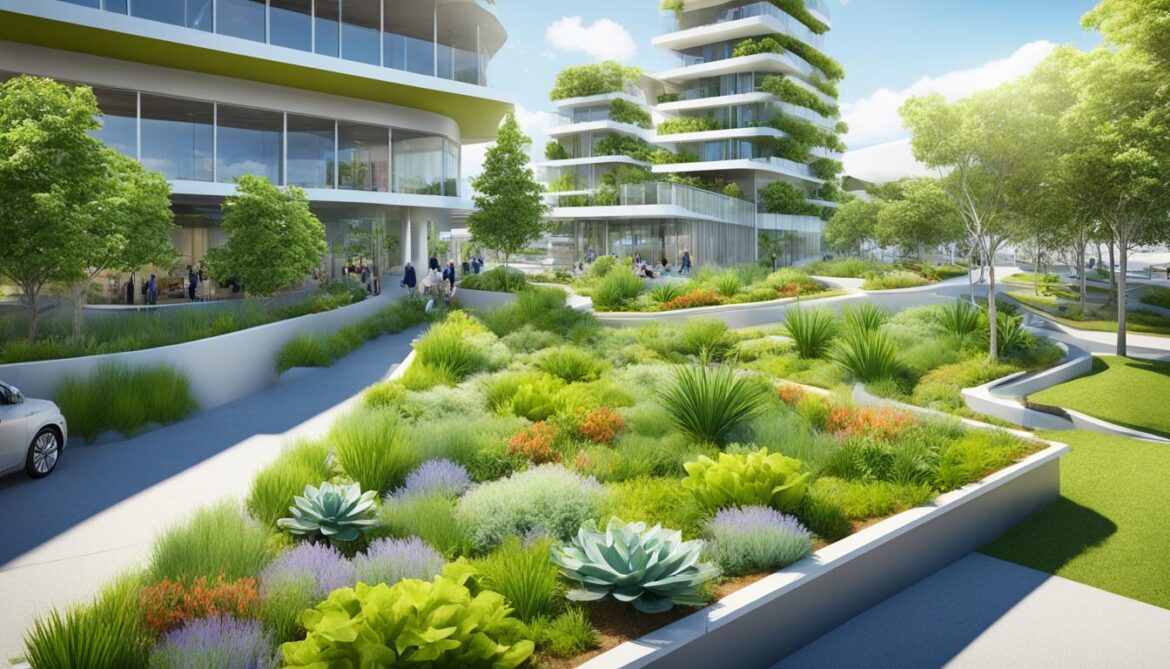
| Benefits of Green Infrastructure in Urban Planning | Examples |
|---|---|
| Creation of habitats for native species | Development of wildlife corridors and green spaces that promote biodiversity |
| Improvement of air and water quality | Integration of vegetative systems that filter pollutants and reduce stormwater runoff |
| Mitigation of urban development impacts on biodiversity | Inclusion of green roofs and walls to offset the loss of natural habitats |
| Enhancement of overall well-being and quality of life | Provision of recreational spaces and opportunities for physical activity |
With its commitment to incorporating green infrastructure in urban planning, Nauru is taking steps towards creating sustainable and environmentally conscious cities. By prioritizing ecological diversity, Nauru is not only improving the overall health and well-being of its population but also ensuring the long-term preservation of its unique natural heritage.
Environmental Impact Assessment in Development Projects
Nauru recognizes the importance of conducting environmental impact assessments (EIAs) for development projects to minimize negative impacts on biodiversity. EIAs evaluate the potential environmental effects of proposed projects and identify measures to mitigate these impacts. By integrating EIA processes into decision-making processes, Nauru aims to ensure that development activities are carried out sustainably and do not harm the country’s biodiversity. Effective implementation and enforcement of EIA regulations are essential for achieving this goal.
Key Benefits of Environmental Impact Assessments
- Identify potential impacts: EIAs help to identify the potential environmental impacts of proposed projects, including the effects on biodiversity, ecosystems, water resources, and air quality.
- Promote sustainable development: By considering the environmental impacts of development projects, EIAs help to promote sustainable development practices that balance economic growth with the conservation of natural resources.
- Inform decision making: EIAs provide valuable information to decision-makers, including government agencies, investors, and project developers, enabling them to make informed choices that minimize negative impacts on biodiversity.
- Encourage stakeholder participation: Environmental impact assessments provide opportunities for public participation, allowing stakeholders to voice their concerns and contribute to the decision-making process.
- Identify mitigation measures: EIAs recommend measures to mitigate identified environmental impacts, such as implementing biodiversity conservation plans, adopting eco-friendly technologies, and minimizing waste generation.
“Environmental impact assessments play a crucial role in ensuring that development projects in Nauru are carried out sustainably, minimizing harm to the country’s unique biodiversity and ecosystem.” – Environmental Expert
To illustrate the significance of environmental impact assessments, consider the example of a proposed construction project in Nauru. Without an EIA, the project could potentially damage fragile ecosystems, disrupt wildlife habitats, or contribute to pollution. However, by conducting a comprehensive EIA, potential risks can be identified, and suitable mitigation measures can be incorporated into the project plan to protect Nauru’s biodiversity.
| Benefits of Environmental Impact Assessments | Examples |
|---|---|
| Ensures sustainable development | By integrating biodiversity conservation measures into infrastructure projects, Nauru can balance economic development with environmental protection. |
| Promotes stakeholder involvement | Through public consultations and engagement with local communities, EIAs allow stakeholders to contribute their knowledge and concerns. |
| Minimizes negative environmental impacts | By identifying potential risks, such as habitat destruction or pollution, EIAs enable the implementation of measures to mitigate these impacts. |
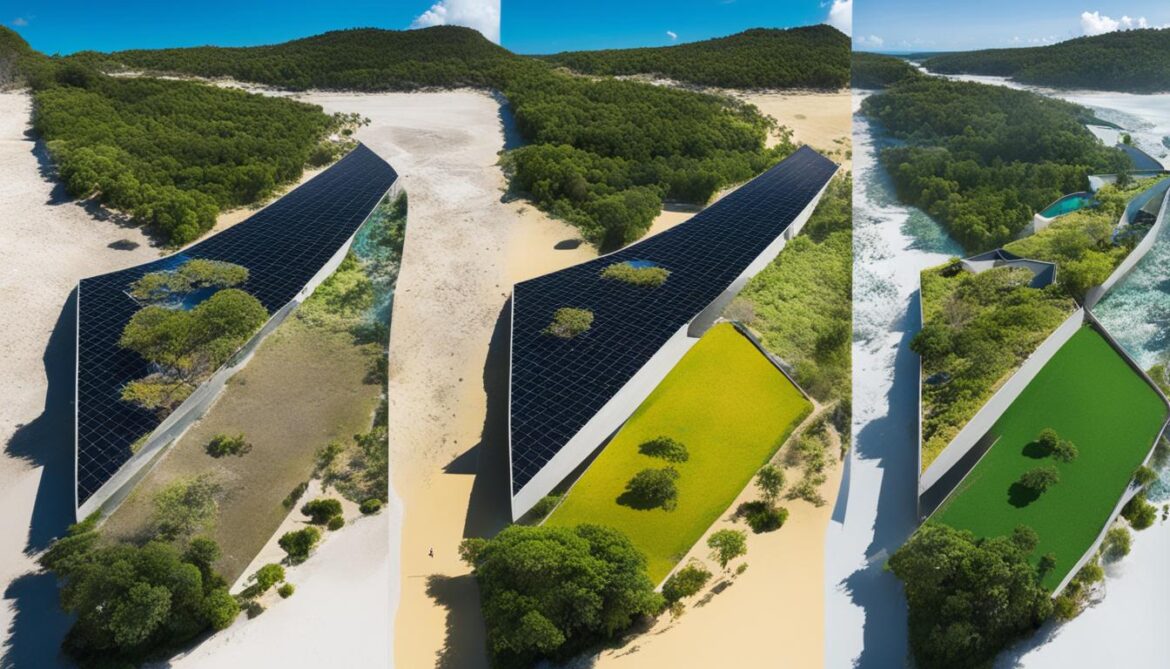
Sustainable Architecture and Design
Nauru is embracing sustainable architecture and design practices to promote ecological diversity. Sustainable architecture focuses on minimizing the environmental impacts of buildings through energy-efficient design, use of renewable materials, and integration of green technologies. By implementing sustainable architecture and design principles, Nauru aims to create buildings and infrastructure that harmonize with the natural environment, support biodiversity, and reduce greenhouse gas emissions. Sustainable architecture and design also contribute to the overall sustainability of the built environment.
Through sustainable architecture, Nauru strives to create a built environment that not only serves the needs of its inhabitants but also respects and preserves the delicate ecological balance of the island. Buildings designed with sustainability in mind prioritize energy efficiency by utilizing natural light, employing passive cooling techniques, and incorporating renewable energy sources such as solar panels. These measures not only reduce the carbon footprint of buildings but also contribute to a healthier and more sustainable living environment.
In addition to energy efficiency, sustainable design principles also emphasize the use of renewable and environmentally friendly materials. By selecting materials that have a minimal environmental impact, such as sustainably sourced timber and recycled materials, Nauru promotes responsible resource management and reduces the depletion of natural resources. Furthermore, sustainable design seeks to minimize waste through efficient construction practices, recycling, and the use of innovative building techniques.
Sustainable architecture goes beyond individual buildings; it encompasses the planning and development of entire communities. By integrating green spaces, pedestrian-friendly pathways, and water-sensitive design, Nauru is creating sustainable urban environments that support biodiversity and enhance the well-being of its residents.
Promoting Biodiversity
One of the key objectives of sustainable architecture in Nauru is to promote ecological diversity. By incorporating green infrastructure into building design, such as rooftop gardens, vertical green walls, and urban forests, Nauru creates habitats for native species within urban areas. These green spaces serve as corridors for wildlife, allowing them to move freely and maintain healthy populations. Furthermore, the integration of water features, rain gardens, and natural drainage systems helps to preserve water resources and enhance the biodiversity of aquatic ecosystems.
The use of sustainable architecture and design principles in Nauru not only creates aesthetically pleasing and functional buildings but also contributes to the preservation of the island’s natural heritage. By harmonizing with the surrounding environment, sustainable buildings blend seamlessly into the landscape, minimizing their visual impact and providing a sense of continuity with the natural surroundings.
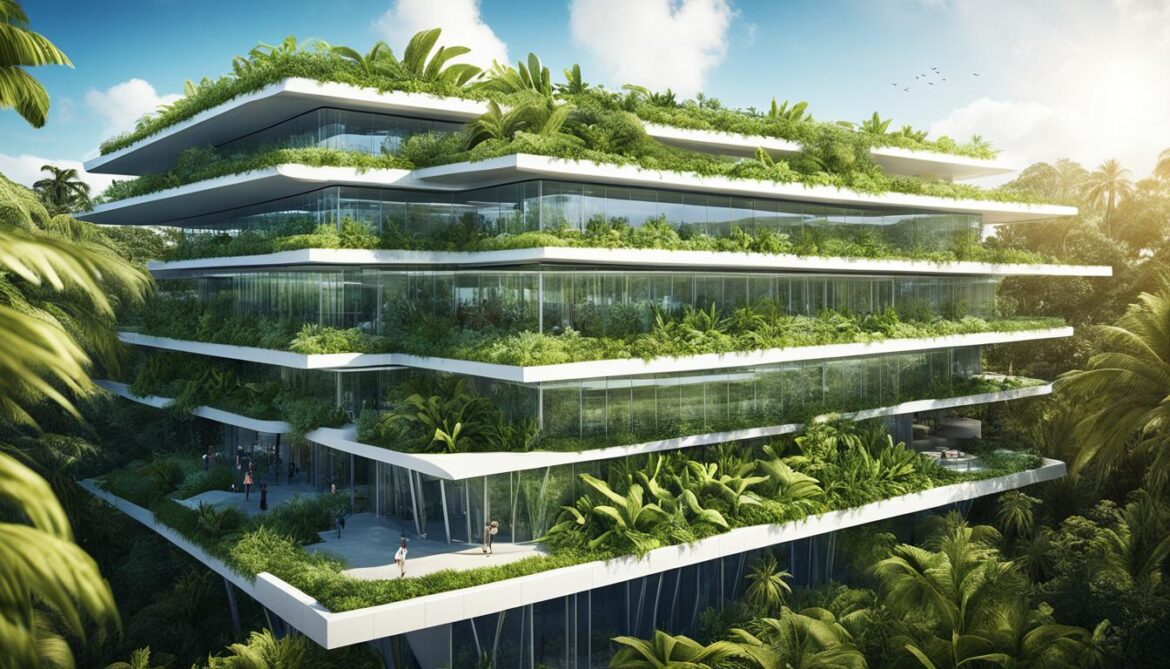
The Benefits of Sustainable Architecture
| Benefits of Sustainable Architecture | Examples |
|---|---|
| Reduced energy consumption | Implementation of energy-efficient systems, such as solar panels and passive cooling techniques |
| Improved indoor air quality | Use of natural ventilation systems and low-VOC (Volatile Organic Compounds) materials |
| Enhanced well-being and comfort | Integration of biophilic design elements, such as natural light and green spaces |
| Minimized environmental impact | Selection of sustainable materials and construction techniques |
| Promotion of biodiversity | Inclusion of green roofs, vertical gardens, and water-sensitive design |
Biodiversity Conservation Challenges and Solutions in Nauru
Biodiversity conservation in Nauru faces several challenges that threaten the country’s unique ecosystems. These challenges include:
- Phosphate mining: The extraction of phosphate, a valuable natural resource, has resulted in habitat destruction and loss of biodiversity.
- Unsustainable population growth: The increasing population puts pressure on land and resources, leading to further degradation of natural habitats.
- Climate change impacts: Rising temperatures, sea-level rise, and extreme weather events pose significant risks to Nauru’s delicate ecosystems and species.
- Over-exploitation of resources: The unsustainable use of land and marine resources depletes biodiversity and disrupts ecological balance.
- Invasive species: Introduced plants and animals disrupt native ecosystems, outcompeting native species and causing ecosystem imbalances.
- Pollution: Improper waste management and pollution control measures contribute to water and air pollution, affecting both terrestrial and marine biodiversity.
- Loss of traditional knowledge: The decline in traditional knowledge and practices leads to a loss of valuable insights into sustainable coexistence with nature.
To address these challenges and ensure the long-term preservation of Nauru’s unique ecosystems, the country is implementing various solutions:
- The National Biodiversity Strategy and Action Plan (NBSAP) provides a comprehensive framework for biodiversity conservation, outlining specific goals and actions.
- Nauru is actively seeking additional funding from international organizations and partners to support biodiversity conservation efforts.
- Building capacity within local communities and government agencies to effectively manage and protect biodiversity.
- Fostering collaboration between stakeholders, including government bodies, NGOs, and local communities, to address conservation challenges collectively.
- Promoting public awareness and engagement through educational programs, campaigns, and initiatives to encourage sustainable practices and appreciation for biodiversity.
Biodiversity Conservation Challenges and Solutions in Nauru
| Challenges | Solutions |
|---|---|
| Phosphate mining | The implementation of strict regulations on mining practices and the reclamation of mined areas to restore habitats. |
| Unsustainable population growth | Implementing sustainable population management strategies and promoting family planning initiatives. |
| Climate change impacts | Adopting climate change adaptation measures, such as coastal protection and promoting renewable energy sources. |
| Over-exploitation of resources | Enforcing sustainable resource management practices and establishing protected areas. |
| Invasive species | Implementing invasive species control programs and preventing further introductions through robust biosecurity measures. |
| Pollution | Improving waste management systems and implementing effective pollution control measures. |
| Loss of traditional knowledge | Revitalizing traditional knowledge through cultural preservation initiatives and incorporating traditional practices into conservation efforts. |
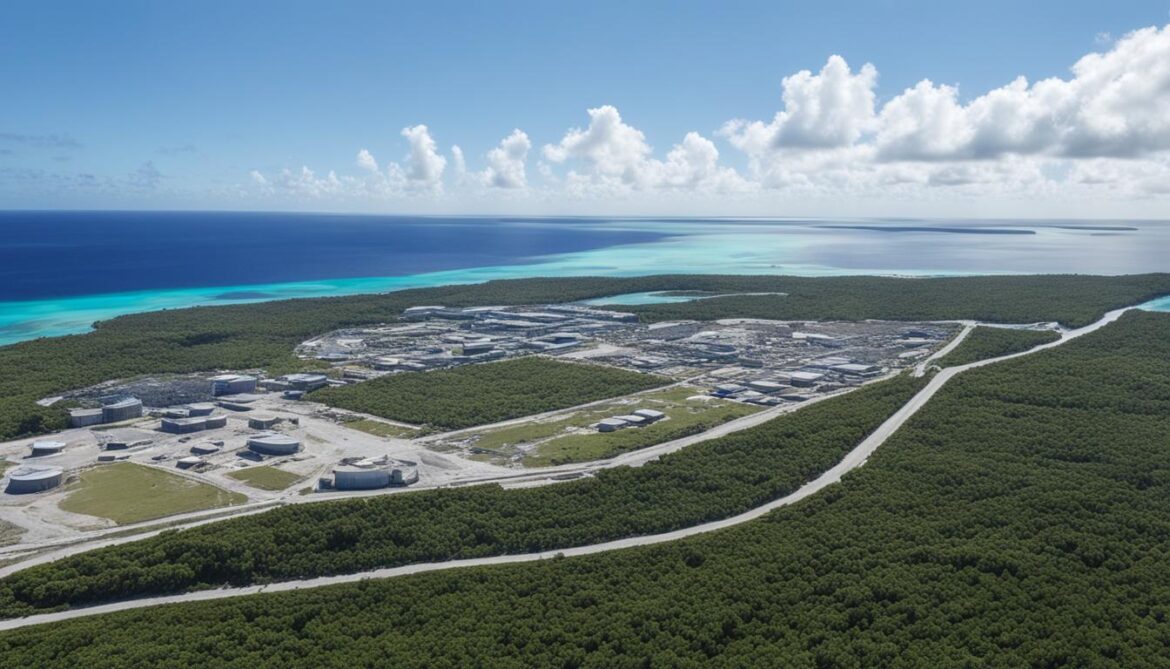
By addressing these challenges and implementing effective solutions, Nauru aims to safeguard its precious biodiversity and ensure a sustainable future for its ecosystems and future generations.
Targets and Implementation Measures for Biodiversity Conservation in Nauru
Nauru, as a committed advocate for biodiversity conservation, has established specific targets at the national level and implemented measures to achieve them. These targets aim to protect and preserve the rich natural heritage of Nauru for future generations. The National Biodiversity Strategy and Action Plan (NBSAP) serves as a comprehensive framework for guiding conservation efforts across the country.
The NBSAP outlines eight thematic areas that prioritize the conservation of biodiversity in Nauru:
- Ecosystems Management
- Species Management
- Access and Benefit-Sharing from the Use of Genetic Resources
- Agro-Biodiversity
By focusing on these areas, Nauru aims to address the key challenges faced by its unique and fragile ecosystems, ensuring the long-term sustainability of its biodiversity.
| Thematic Areas | Description |
|---|---|
| Ecosystems Management | Conserving and restoring natural habitats, including forests, coral reefs, and coastal areas, to support the survival of native species and maintain ecosystem functionality. |
| Species Management | Protecting and managing native species, including endangered and endemic species, through effective conservation measures, such as habitat restoration and protected area management. |
| Access and Benefit-Sharing from the Use of Genetic Resources | Establishing guidelines and regulations for the sustainable use of genetic resources found in Nauru’s biodiversity, ensuring equitable sharing of benefits derived from their utilization. |
| Agro-Biodiversity | Preserving and promoting the diversity of plant and animal species used in agriculture, including traditional crop varieties and livestock breeds, to enhance food security and sustainable farming practices. |
While Nauru has made commendable progress in implementing the NBSAP, challenges related to funding and capacity constraints have hindered its full realization. In order to align with global frameworks for biodiversity conservation, it is essential to review and update the NBSAP on a regular basis, incorporating the latest scientific knowledge and best practices.
Nauru’s commitment to biodiversity conservation is commendable. By setting targets and implementing strategic measures, the country is taking significant steps towards protecting its unique ecosystems and preserving its natural heritage.
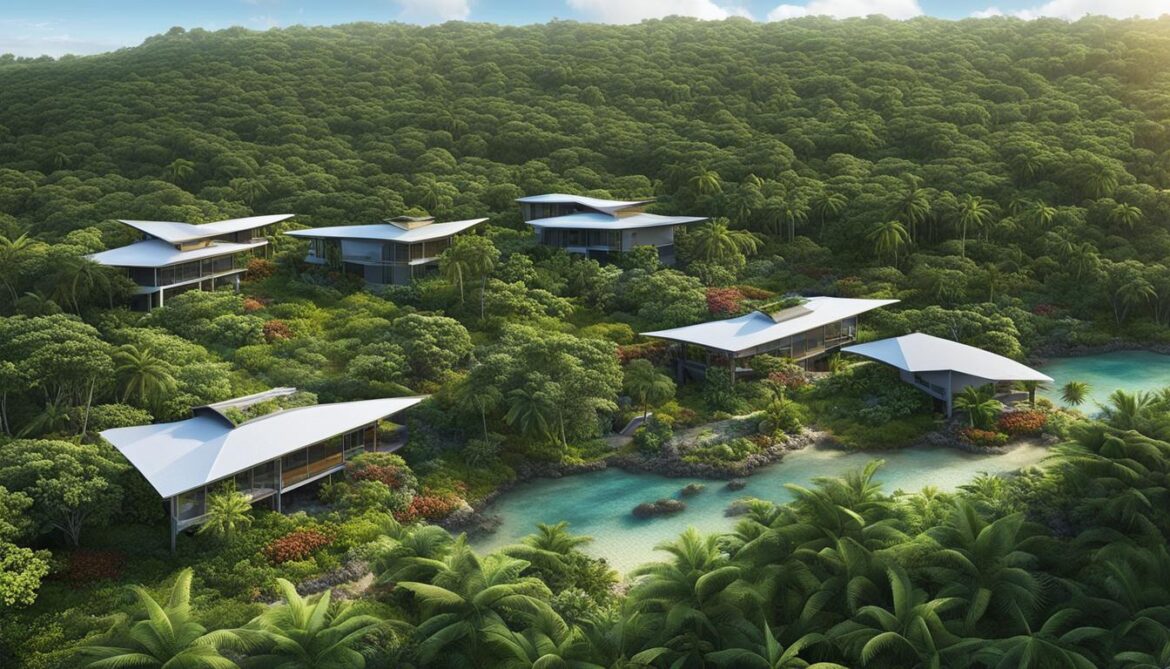
Threats to Nauru’s Biodiversity
Nauru’s biodiversity faces several threats that pose significant challenges to the preservation of its unique ecosystems and native species. These threats encompass a range of issues, including:
- Phosphate Mining: The extensive extraction of phosphate deposits has caused substantial habitat destruction and soil degradation, adversely impacting Nauru’s biodiversity.
- Habitat Destruction: The loss of natural habitats due to urbanization, infrastructure development, and land clearance for agriculture poses a grave threat to Nauru’s native species and their survival.
- Unsustainable Population Growth: Rapid population growth strains the island’s limited resources and exacerbates the demand for land, resulting in further habitat destruction and environmental degradation.
- Climate Change Impacts: Rising sea levels, increased temperatures, and extreme weather events pose significant challenges to Nauru’s delicate ecosystems, leading to habitat loss and changes in species distribution.
- Over-exploitation of Resources: Unsustainable fishing practices, deforestation, and the depletion of natural resources have severe consequences for Nauru’s biodiversity, disrupting ecological balance and threatening species survival.
- Invasive Species: The introduction of non-native species to Nauru has disrupted ecological interactions, outcompeted native species for resources and habitats, and caused substantial harm to the island’s fragile ecosystems.
- Pollution: Poor waste management, inadequate pollution control measures, and pollution from phosphate mining operations contribute to water and air pollution, jeopardizing the health and well-being of Nauru’s biodiversity.
- Loss of Traditional Knowledge: The erosion of traditional knowledge and cultural practices related to biodiversity conservation undermines indigenous strategies for sustainable resource management and protection.
To protect Nauru’s biodiversity for future generations, collaborative efforts and effective conservation strategies are essential. It is crucial to mitigate the impact of phosphate mining, implement sustainable land-use practices, manage population growth sustainably, address climate change through adaptation and mitigation measures, promote responsible resource management, control invasive species, improve pollution control mechanisms, and empower local communities to revive and pass down traditional knowledge and conservation practices.
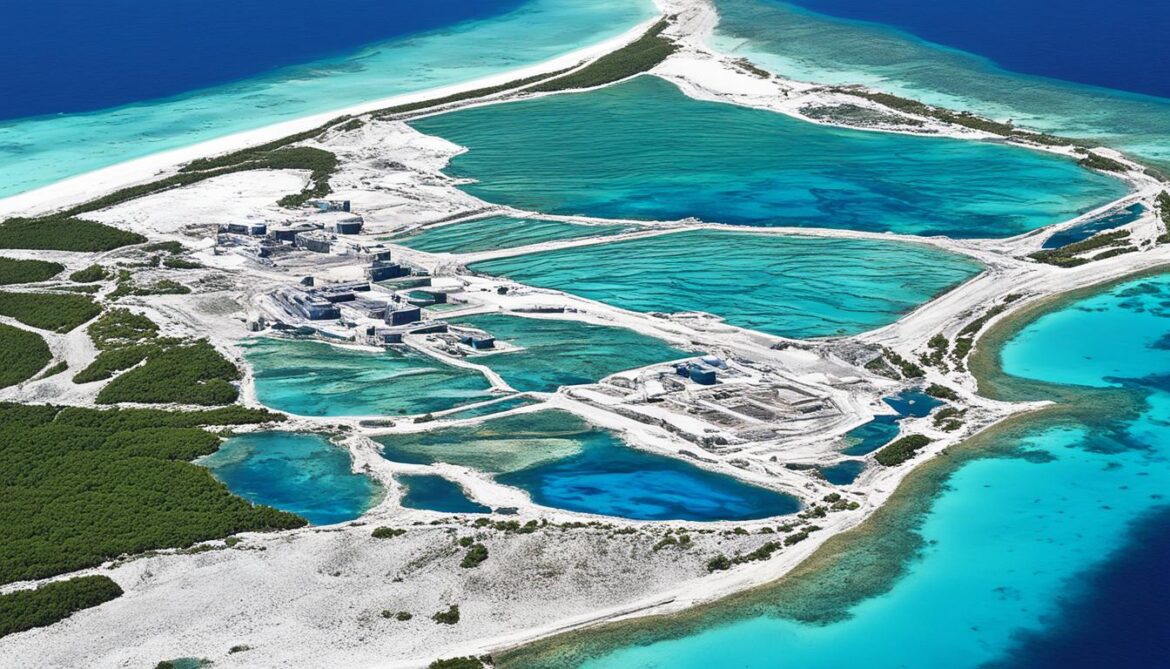
Conclusion
Nauru’s biodiversity and the built environment are inextricably intertwined, highlighting the significance of integrating conservation efforts into urban planning and development projects. Through initiatives like habitat preservation, green infrastructure, and sustainable architecture, Nauru is actively addressing the challenges faced by its unique and fragile biodiversity.
The implementation of the National Biodiversity Strategy and Action Plan (NBSAP) and other collaborative measures emphasize Nauru’s commitment to preserving its natural heritage. Despite the obstacles, such as phosphate mining and unsustainable population growth, Nauru is striving to protect its diverse ecosystems and native species.
By investing in environmentally responsible practices and conducting thorough environmental impact assessments, Nauru aims to ensure that future developments align with sustainable principles and do not harm the country’s biodiversity. The preservation of Nauru’s ecological diversity necessitates sustained collaboration and the adoption of sustainable practices for the long-term well-being of the island nation.




